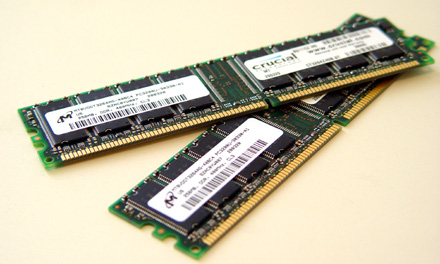Page 3 - Doin' the Dual thang
If you are going to buy a Pentium 4 C class CPU then you should make sure you can run Dual Channel memory with your memory modules (prefereable at 400 MHz). So how do you check this with your current modules ?
This is a good one to remember .. two sticks of 256MB rated DDR400 will outperform one stick of 512MB DDR400). In short, these are the requirements for using dual-channel DDR:
-
Both sticks of memory must be the same size.
-
Both sticks of memory must have the same type of memory chips.
-
Both sticks of memory must have the same speed/latency.
-
Single-sided and double-sided memory sticks can not be mixed.
Basically determine what amount of memory you want in your rig, 512 or 1 GB and buy 2x256 or 2x512 identical memory sticks from the same manufacturer. Several manufacturers also offer you guaranteed the same memory stick and sell it as Dual Channel DDR memory packages.
 Dual Channel DDR memory rated 400MHz from Crucial
Dual Channel DDR memory rated 400MHz from Crucial
You see, the trick is to get the optimal combination of hardware and since the 865/875 chipsets support Pentium 4's with 800 MHz FSB and Dual Channel DDR with an extremely fast memory bandwidth the combo is mighty and powerful.
Next we're going to show some photo's after which we'll start testing the CPU, but first a small statement:
We are a hardware site with an audience that has primarily gamers, therefore we will review CPU's in a somewhat different way then other sites tend to do, mostly with gamers benchmarks. Not because we like them so much, no because I know you want to see that. We could test how fast your spreadsheet's macro function is updated or if that mp3 was encoded 2 seconds faster but I know for a fact you don't care very much about that so why bother. We'll go in-depth the gamers way.
Logic assumes that you need to take a look at the highest resolution tested versus the score. This however is not the case.
The CPU's used are faster than a graphics card can handle. So in the highest resolutions you'll notice not much difference in the results. This is the videocards bottleneck as it can't push any harder. What you need to monitor are the lowest resolutions as the videocard is not limited in raw power or memory bandwidth. I know this may sound a bit weird but the Radeon 9700 Pro that we used is actually a limiting factor for the CPU in the highest resolutions. Bare that in mind as we try to demonstrate the power of the CPU and not the graphics card.
SiSoft Sandra was used to measure CPU and Memory Bandwidth, while MadOnion's PC Mark 2002 was also used to measure memory bandwidth and CPU performance. Furthermore several OpenGL and Direct3D games like Splinter Cell, Unreal Tournament 2003, Doom III Alpha and return to Castle Wolfenstein were used to measure real-world multimedia performance.
| Test system |
|
Test system setup:
Benchmark Software Suite:
* disabled while benchmarking |
